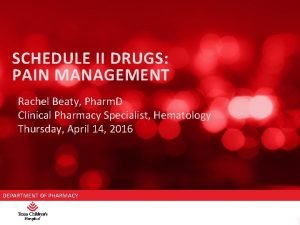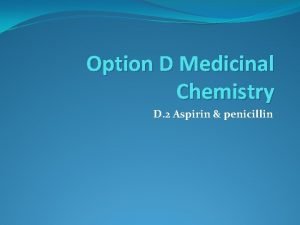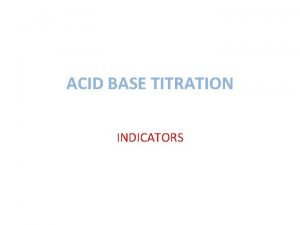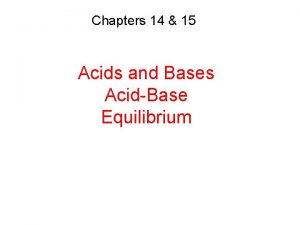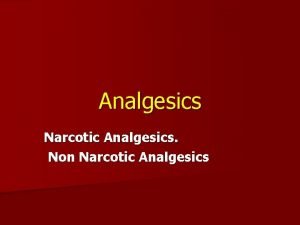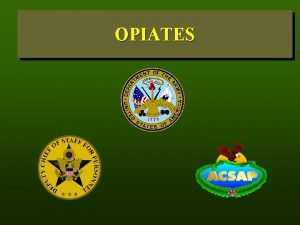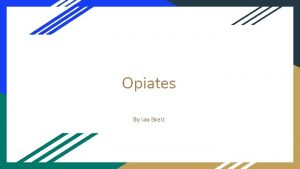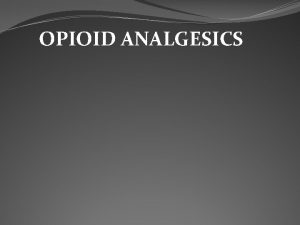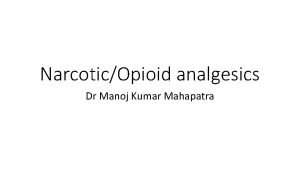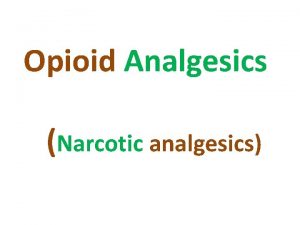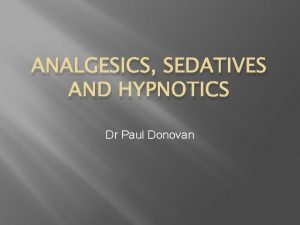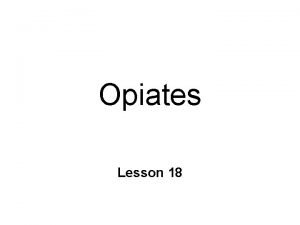Opiates Opioids Opiates opioids are strong analgesics Opiates



















- Slides: 19

Opiates

Opioids Opiates (opioids) are strong analgesics. Opiates bind to receptors in the brain, which means that they kill pain by preventing the transmission of pain impulses in the brain, rather than at the source. Opiates are derived from opium, which is found in poppy seeds.

Opioids Opiates bind temporarily to opioid receptors in the brain, which block the transmission of impulses between brain cells that would signal pain. Because these analgesics act on the brain, they may cause possible changes in behavior and mood, so they are known as narcotics. Opioids are very effective painkillers for severe pain, but have side effects and potential problems of dependence, so their usage has to be monitored.

Opioids In order to enter the brain, opiates must pass through the blood-brain barrier, which is a membrane that surrounds the brain and protects it by restricting the chemicals that can enter from the blood. The blood-brain barrier is made largely of lipids, which are non-polar molecules. So, polar molecules do not enter the brain. For the drug to penetrate the barrier and enter the brain, it will be more effective if it is a non-polar and lipid soluble drug.

Opioids The narcotic drugs derived from opium are primarily morphine and its derivatives. We will consider three of these: codeine, morphine, and diamorphine (known as heroin).


Opioids Notice that the three drugs have a common basic structure that accounts for their similar properties, as well as some different functional groups. Morphine is the main drug derived from opium. When administered through intravenous injection, it has about six times the bioavailability as when taken orally. The two –OH groups in morphine give it some polarity which limits ability to cross the blood-brain barrier.

Opioids Codeine is found in low levels in opium, but is more commonly prepared from morphine. It is known as a semi-synthetic drug because it is produced from a compound isolated from a natural source. Morphine is converted into codeine by methylation, a process in which a methyl group replaces a hydrogen atom. This causes the –OH group to be converted into the methyl ether. methylation

Opioids The process of methylation makes codeine a less polar molecule than morphine, which allows to cross the blood-brain barrier more easily. However the conversion also causes a significant drop in the binding at the opioid receptors, which makes codeine a weaker analgesic than morphine.

Opioids Diamorphine (heroin) is produced by an esterification reaction in which both –OH groups are converted into esters groups by a reaction with ethanoic acid or ethanoic anhydride. This reduces the polarity significantly, making diamorphine much more lipid soluble than morphine, and more able to cross the blood-brain barrier. Diamorphine is faster acting than the other opioid drugs. esterification

Opioids

Opioids Diamorphine has a much greater potency than morphine, reaching the brain cells faster and in higher concentration. It is more active by a factor of two. It also has greater side-effects as well as a greater potential for tolerance and dependence. Inside the brain, diamorphine must undergo metabolic change before it can act at the opioid receptors. The ester links are broken by enzymes called esterase. For this reason diamorphine is described as a pro-drug, meaning that its metabolic products, mostly morphine, actually bring about its effects. The molecular structure of diamorphine can be thought as a way of “packaging” the morphine so that it can reach its target more efficiently.

Opioids

Opioids Pain management- the World Health Organization has developed a three-step “analgesic ladder” for pain management. 1. Use mild analgesics 2. Add a weak opioid such as codeine or tramadol 3. In severe intractable pain, use strong opioids such as morphine, methadone, or possibly diamorphine.

Opioids Side Effects- Strong analgesics have several other effects that can sometimes be used for therapeutic purposes, but sometimes are considered adverse side-effects. They include: The constipating effects of mild opioids are sometimes used in medication. For example, a mixture of kaolin and morphine is used to treat cases of diarrhea because the morphine reduces the muscle contractions in the lower gut and slows down the passage of fecal matter.

Opioids Narcotic effects and addiction – Narcotics depress brain function, induce sleep, and are potentially addictive. Diamorphine is the most potent narcotic, causing the problem of heroin addiction. In the short-term, heroin induces a feeling of well-being and contentment, as it causes a dulling of pain and a lessening of fear and tension. There is often a feeling of euphoria in the initial stages after intake. Relatively quickly, heroin users start to show dependence, so they cannot function properly without the drug and suffer from withdrawal symptoms such as cold sweats and anxiety if not taken. This is compounded by an increasing tolerance to the drug, so higher doses are needed to bring about relief.


Opioids Since the drug is taken by injection, the user commonly picks up infections such as HIV and hepatitis from unclean needles.

Opioids Helping heroin addicts to break their dependence is a slow and difficult process. Addiction Treatment – methadone is used as an alternative analgesic. It is taken orally and has a longer duration of action. This can reduce drug craving and prevent withdrawal symptoms.
 Insidan region jh
Insidan region jh Be strong be strong be strong in the lord
Be strong be strong be strong in the lord Opioids for neuropathic pain
Opioids for neuropathic pain Liquid gabapentin for cats dosage chart
Liquid gabapentin for cats dosage chart Mechanism of action of opioid analgesics
Mechanism of action of opioid analgesics Classification of analgesic
Classification of analgesic Weak base strong acid titration curve
Weak base strong acid titration curve Difference between strong and weak acids
Difference between strong and weak acids Weak acid and weak base
Weak acid and weak base Strong acid titration curve
Strong acid titration curve Neutralization reaction
Neutralization reaction How to remember strong acids and strong bases
How to remember strong acids and strong bases Good thesis statement
Good thesis statement There's a hero inside of you
There's a hero inside of you Seven strong acids
Seven strong acids Is h3po4 strong or weak
Is h3po4 strong or weak Strong interaction feynman diagram
Strong interaction feynman diagram Standing strong through the storm
Standing strong through the storm H2so4 strong or weak
H2so4 strong or weak Strong versus weak acids worksheet answers
Strong versus weak acids worksheet answers


